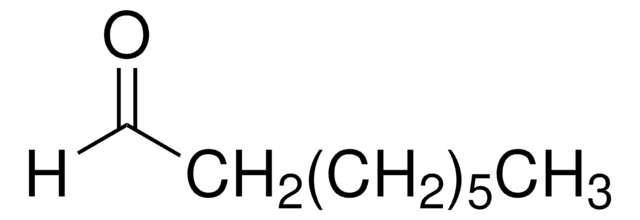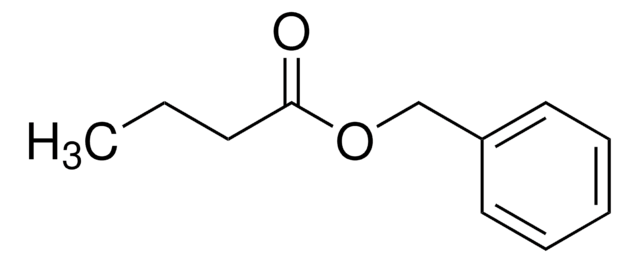W218626
Butyl butyrate
natural, ≥98%, FCC, FG
Sinonimo/i:
Butanoic acid butyl ester, Butyl butanoate, Butyric acid butyl ester
About This Item
Prodotti consigliati
Grado
FG
Fragrance grade
Halal
Kosher
natural
Livello qualitativo
agenzia
follows IFRA guidelines
meets purity specifications of JECFA
Conformità normativa
EU Regulation 1223/2009
EU Regulation 1334/2008 & 178/2002
FCC
FDA 21 CFR 117
Saggio
≥98%
Caratteristiche più verdi
Less Hazardous Chemical Syntheses
Use of Renewable Feedstocks
Learn more about the Principles of Green Chemistry.
sustainability
Greener Alternative Product
Indice di rifrazione
n20/D 1.406 (lit.)
P. eboll.
164-165 °C (lit.)
Densità
0.869 g/mL at 25 °C (lit.)
applicazioni
flavors and fragrances
Documentazione
see Safety & Documentation for available documents
Allergene alimentare
no known allergens
Allergene in fragranze
no known allergens
Categoria alternativa più verde
Organolettico
green; fruity; sweet
Stringa SMILE
CCCCOC(=O)CCC
InChI
1S/C8H16O2/c1-3-5-7-10-8(9)6-4-2/h3-7H2,1-2H3
XUPYJHCZDLZNFP-UHFFFAOYSA-N
Cerchi prodotti simili? Visita Guida al confronto tra prodotti
Categorie correlate
Applicazioni
- Recruitment of Hippodamia variegata by active volatiles from Glycyrrhiza uralensis and Alhagi sparsifolia plants infested with Aphis atrata.: This research explores the role of butyl butyrate as a volatile compound in attracting predatory insects to plants infested with aphids. The study provides valuable insights into plant-insect interactions and the potential use of natural volatiles in integrated pest management (Jiang et al., 2024).
Avvertenze
Warning
Indicazioni di pericolo
Consigli di prudenza
Classi di pericolo
Aquatic Chronic 2 - Flam. Liq. 3
Codice della classe di stoccaggio
3 - Flammable liquids
Classe di pericolosità dell'acqua (WGK)
WGK 2
Punto d’infiammabilità (°F)
124.9 °F - closed cup
Punto d’infiammabilità (°C)
51.6 °C - closed cup
Dispositivi di protezione individuale
Eyeshields, Faceshields, Gloves, type ABEK (EN14387) respirator filter
Certificati d'analisi (COA)
Cerca il Certificati d'analisi (COA) digitando il numero di lotto/batch corrispondente. I numeri di lotto o di batch sono stampati sull'etichetta dei prodotti dopo la parola ‘Lotto’ o ‘Batch’.
Possiedi già questo prodotto?
I documenti relativi ai prodotti acquistati recentemente sono disponibili nell’Archivio dei documenti.
Il team dei nostri ricercatori vanta grande esperienza in tutte le aree della ricerca quali Life Science, scienza dei materiali, sintesi chimica, cromatografia, discipline analitiche, ecc..
Contatta l'Assistenza Tecnica.








